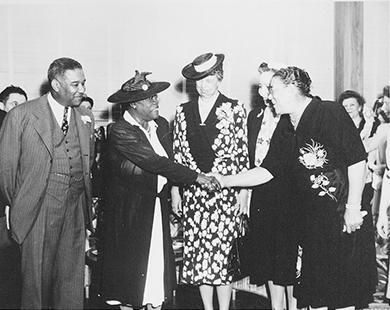| << Chapter < Page | Chapter >> Page > |
Critics point out that not all Americans benefited from the New Deal. African Americans in particular were left out, with overt discrimination in hiring practices within the federal job programs, such as the CCC, CWA, and WPA. The NRA was oftentimes criticized as the “Negro Run Around” or “Negroes Ruined Again” program. As well, the AAA left tenant farmers and sharecroppers, many of whom were black, with no support. Even Social Security originally excluded domestic workers, a primary source of employment for African American women. Facing such criticism early in his administration, Roosevelt undertook some efforts to ensure a measure of equality in hiring practices for the relief agencies, and opportunities began to present themselves by 1935. The WPA eventually employed 350,000 African Americans annually, accounting for nearly 15 percent of its workforce. By the close of the CCC in 1938, this program had employed over 300,000 African Americans, increasing the black percentage of its workforce from 3 percent at the outset to nearly 11 percent at its close. Likewise, in 1934, the PWA began to require that all government projects under its purview hire African Americans using a quota that reflected their percentage of the local population being served. Additionally, among several important WPA projects, the Federal One Project included a literacy program that eventually reached over one million African American children, helping them learn how to read and write.
On the issue of race relations themselves, Roosevelt has a mixed legacy. Within his White House, Roosevelt had a number of African American appointees, although most were in minor positions. Unofficially, Roosevelt relied upon advice from the Federal Council on Negro Affairs, also known as his “ Black Cabinet .” This group included a young Harvard economist, Dr. Robert Weaver, who subsequently became the nation’s first black cabinet secretary in 1966, as President Lyndon Johnson’s Secretary of Housing and Urban Development. Aubrey Williams, the director of the NYA, hired more black administrators than any other federal agency, and appointed them to oversee projects throughout the country. One key figure in the NYA was Mary McLeod Bethune ( [link] ), a prominent African American educator tapped by Roosevelt to act as the director of the NYA’s Division of Negro Affairs. Bethune had been a spokesperson and an educator for years; with this role, she became one of the president’s foremost African American advisors. During his presidency, Roosevelt became the first to appoint a black federal judge, as well as the first commander-in-chief to promote an African American to brigadier general. Most notably, he became the first president to publicly speak against lynching as a “vile form of collective murder.”


Notification Switch
Would you like to follow the 'U.s. history' conversation and receive update notifications?